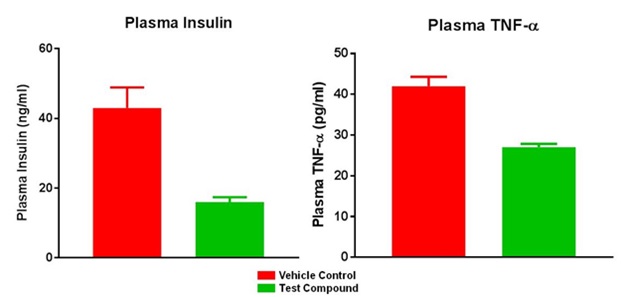The ob/ob mouse model differs from db/db mouse in that it has leptin deficiency but the leptin signaling is intact. These mice are hyperphagic and rapidly become obese. The adipose tissue in ob/ob mice grows both through hypertrophy and through hyperplasia of adipocytes. Pancreatic b-cell hyperplasia and hypertrophy results in hyperinsulinemia by 2 weeks, glucose intolerance and hyperglycemia by 4 weeks of age. The expression of genes involved in lipogenesis and gluconeogenesis are upregulated in these mice and severe insulin resistance is attributed to reduced insulin recognition and signal transduction by the insulin receptor and to decreased glucose transport in insulin responsive tissues. The ob/ob mouse model can be used to test the compounds activity on improving hyperglycemia, hyperinsulinemia, hyperlipidemia and adipocytokines.

We offer preclinical efficacy, proof-of-concept and mechanism of action studies with your drug candidates. We work with our clients in providing scientific guidance, customized study design, end-point analysis, histopathology services, and will assist you with professional interpretation of the data. Please contact us with your specific needs.
Relevant publications by our scientists:
1. Yu XX, Murray SF, Pandey SK, Booten SL, Bao D, Song XZ, Kelly S, Chen S, McKay R, Monia BP, Bhanot S. Hepatology. 2005 Aug;42(2):362-71. PMID: 16001399
2. Watts LM, Manchem VP, Leedom TA, Rivard AL, McKay RA, Bao D, Neroladakis T, Monia BP, Bodenmiller DM, Cao JX, Zhang HY, Cox AL, Jacobs SJ, Michael MD, Sloop KW, Bhanot S. Diabetes. 2005, 54(6):1846-1853. PMID: 15919808
3. Pandey SK, Yu XX, Watts LM, Michael MD, Sloop KW, Rivard AR, Leedom TA, Manchem VP, Samadzadeh L, McKay RA, Monia BP, Bhanot S. J Biol Chem. 2007 May 11;282(19):14291-14299. PMID: 17353188